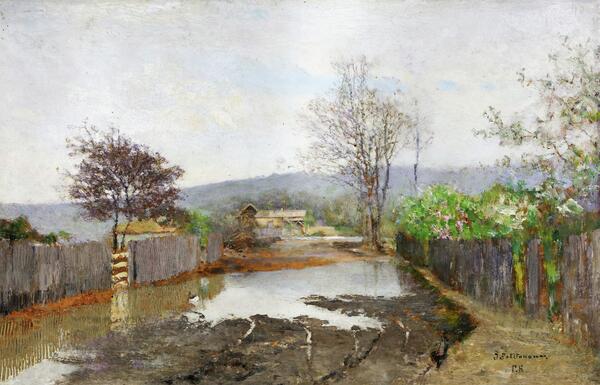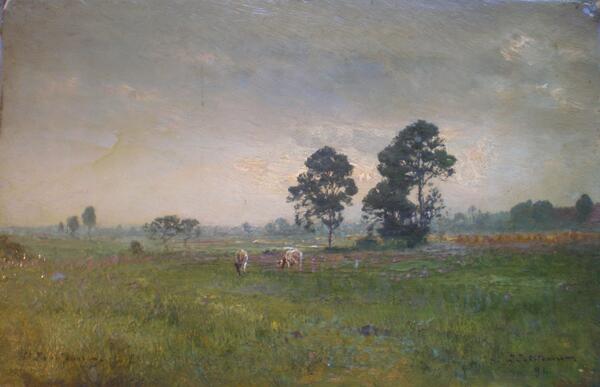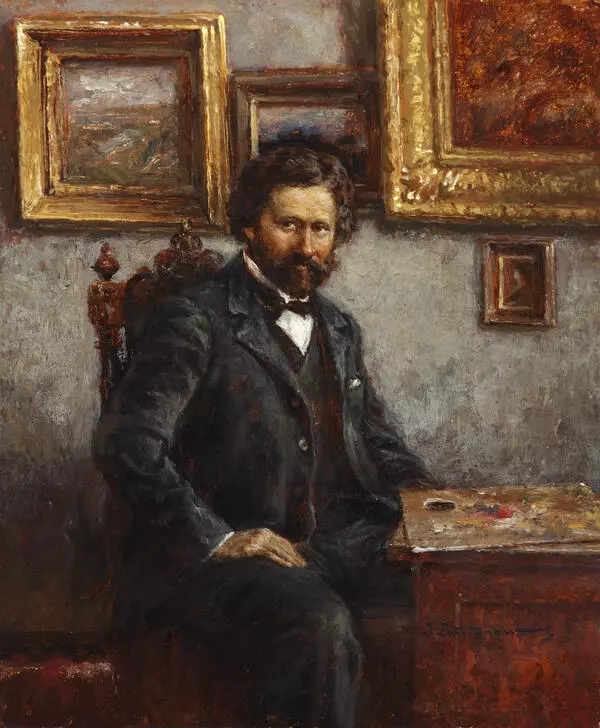Landscape master Ivan Pokhitonov did not receive a formal art education. He graduated from a private boarding school, then studied at the Cadet Corps in Poltava and later at the vocational school in Nikolayev. In 1868, Pokhitonov entered the Petrovsko-Razumovskaya Agricultural and Forestry Academy in Moscow. A year later he was expelled for participation in the revolutionary political organization Narodnaya Volya and exiled to the family estate Matryonovka in the Kherson Governorate. There he was under police supervision for a year.
In 1870, Pokhitonov moved to Odessa and entered the Natural Sciences Department of the Physics and Mathematics Faculty of Novorossiysk University. There he studied with the famous biologist Ilya Mechnikov and became interested in zoology and ornithology. The future artist worked as an inspector of cash registers at the State Bank of Odessa and later quit his job and became the manager of his father’s estate. At the same time, he studied drawing and watercolors on his own.
For the first time, Pokhitonov participated in an art exhibition in 1871 in Geneva. In the second half of the 1870s, he lived in Italy and then in France, where he honed his skills in the studio of the painter and graphic artist Eugene Carriere. In 1893, the artist spent some time in Belgium, then moved to the Minsk Governorate, but after a few years, he returned to the Belgian commune Juprelle.
In 1911, a personal exhibition of Pokhitonov was held at the Lemercier Gallery in Moscow. In 1913 he came to St. Petersburg, where, due to World War I, he lived until 1917. Then the artist moved to Kuban, lived in Yekaterinodar and Goryachy Klyuch, and in 1919 he returned to Belgium. Pokhitonov worked until the end of his life. The artist died in Brussels at the age of 73.
Pokhitonov painted “Goryachy Klyuch. After the Flood” in 1918–1919, when he lived in Kuban. He depicted a spring landscape with puddles, trees blooming along the road, cloudy skies, and mountains in the background. Pokhitonov painted the picture on a small board of lemon wood. He worked on the miniature painting with special tools, including the finest brushes, a palette knife, fish bones and scalpels. Besides, the artist used a magnifying glass to enhance the image and double glasses, that had both magnifying and distance glasses.
Pokhitonov created the landscape “Goryachy Klyuch. After the Flood” using a combination of color shades. In this work, the artist united the traditions of the Russian landscape school and the techniques of the Barbizon school: realism and the creation of a study from nature in the open-air with the subsequent completion of the picture in the studio.
In 1870, Pokhitonov moved to Odessa and entered the Natural Sciences Department of the Physics and Mathematics Faculty of Novorossiysk University. There he studied with the famous biologist Ilya Mechnikov and became interested in zoology and ornithology. The future artist worked as an inspector of cash registers at the State Bank of Odessa and later quit his job and became the manager of his father’s estate. At the same time, he studied drawing and watercolors on his own.
For the first time, Pokhitonov participated in an art exhibition in 1871 in Geneva. In the second half of the 1870s, he lived in Italy and then in France, where he honed his skills in the studio of the painter and graphic artist Eugene Carriere. In 1893, the artist spent some time in Belgium, then moved to the Minsk Governorate, but after a few years, he returned to the Belgian commune Juprelle.
In 1911, a personal exhibition of Pokhitonov was held at the Lemercier Gallery in Moscow. In 1913 he came to St. Petersburg, where, due to World War I, he lived until 1917. Then the artist moved to Kuban, lived in Yekaterinodar and Goryachy Klyuch, and in 1919 he returned to Belgium. Pokhitonov worked until the end of his life. The artist died in Brussels at the age of 73.
Pokhitonov painted “Goryachy Klyuch. After the Flood” in 1918–1919, when he lived in Kuban. He depicted a spring landscape with puddles, trees blooming along the road, cloudy skies, and mountains in the background. Pokhitonov painted the picture on a small board of lemon wood. He worked on the miniature painting with special tools, including the finest brushes, a palette knife, fish bones and scalpels. Besides, the artist used a magnifying glass to enhance the image and double glasses, that had both magnifying and distance glasses.
Pokhitonov created the landscape “Goryachy Klyuch. After the Flood” using a combination of color shades. In this work, the artist united the traditions of the Russian landscape school and the techniques of the Barbizon school: realism and the creation of a study from nature in the open-air with the subsequent completion of the picture in the studio.





